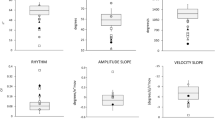Abstract
Mutations in the parkin gene (PARK2) are the most frequent cause of autosomal recessive early–onset Parkinson disease. We performed a transcranial magnetic stimulation study in four patients with parkin mutations. Two patients had a prolonged central motor conduction time at both upper and lower limb, one only at the arm and one only at the leg. The MEP threshold was increased in one patient for the arm and in two for the leg. The MEP amplitude was reduced in one and central silent period shortened in two. The findings demonstrate corticospinal dysfunction in these patients and suggest that the extent of central nervous system involvement in parkin disease may be wider that hitherto supposed.
Similar content being viewed by others
References
Alexander GE, Crutcher MD (1990) Functional architecture of basal ganglia circuits. Neural substrates of parallel processing. Trends Neurosci 13:266–271
Berardelli A, Rona S, Inghilleri M, et al. (1996) Cortical inhibition in Parkinson’s disease. A study with paired magnetic stimulation. Brain 119:71–77
Cantello R, Gianelli M, Bettucci D, et al. (1991) Parkinson’s disease rigidity: Magnetic motor evoked potentials in a small hand muscle. Neurology 41:1449–1456
Davey NJ, Dick JPR, Ellaway PH, et al. (1991) Raised motor cortical threshold associated with bradykinesia as revealed by transcranial magnetic stimulation in normal man and Parkinson’s disease. J Physiol 438:35P
Eisen A, Siejka S, Schulzer M, et al. (1991) Age–dependent decline in motor evoked potential (MEP) amplitude: with a comment on changes in Parkinson’s disease. Electroenceph Clin Neurophysiol 81:209–215
Fahn S, Elton RI, and members of the UPDRS Development Committee (1987) Unified Parkinson’s Disease Rating Scale. In: Fahn S, Marsden CD, Calne DB, Goldstein M (eds) Recent Developments in Parkinson’s disease, vol 2. Florham Park, NJ:MacMillian Health Care Information, pp 153–163
Farrer M, Chan P, Chen R, et al. (2001) Lewy bodies and parkinsonism in families with parkin mutations. Ann Neurol 50:293–300
Fuhr P, Agostino R, Hallett M (1991) Spinal motor neuron excitability during the silent period after cortical stimulation. Electroenceph Clin Neurophysiol 81:257–262
Hoehn MM, Yahr MD (1967) Parkinsonism: onset, progression and mortality. Neurology 17:427–442
Itier JM, Ibanez P, Mena MA, et al. (2003) Parkin gene inactivation alters behaviour and dopamine neurotransmission in the mouse. Hum Mol Genet 12:2277–2291
Lohmann E, Periquet M, Bonifati V, et al. (2003) How much phenotypic variation can be attributed to parkin genotype? Ann Neurol Aug 54:176–185
Lücking CB, Dürr A, Bonifati V, et al. (2000) Association between early–onset Parkinson’s disease and mutations in the parkin gene. N Engl J Med 342:1560–1567
Mata IF, Lockhart PJ, Farrer MJ (2004) Parkin genetics: one model for Parkinson’s disease. Hum Mol Genet Apr 1; 13 Spec No 1:R127–33. Epub 2004 Feb 19
Mori H, Kondo T, Yokochi M, et al. (1998) Pathologic and biochemical studies of juvenile parkinsonism linked to chromosome 6q. Neurology 51:890–892
Periquet M, Latouche M, Lohmann E, et al. (2003) Parkin mutations are frequent in patients with isolated early–onset parkinsonism. Brain 126:1271–1278
Priori A, Berardelli A, Inghilleri M, et al. (1994) Motor cortical inhibition and the dopaminergic system. Pharmacological changes in the silent period after transcranial brain stimulation in normal subjects, patients with Parkinson’s disease and drug–induced parkinsonism. Brain 117:317–323
Ridding MC, Inzelberg R, Rothwell JC (1995) Changes in excitability of motor cortical circuitry in patients with Parkinson’s disease. Ann Neurol 37:181–188
Rossini, P, Barker AT, Berardelli A, et al. (1994) Non invasive electrical and magnetic stimulation of the brain, spinal cord and roots: basic principles and procedures for routine clinical application. Report of an IFCN committee. Electroenceph Clin Neurophysiol 91:79–92
Rossini P, Berardelli A, Deuschl G, et al. (1999) Application of magnetic cortical stimulation. “Recommendations for the practice of clinical neurophysiology: guidelines of the international federation of clinical neurophysiology”. chapter 3. 5. Editors Gunther Deuschl and Andrew Eisen, Electroenceph Clin Neurophysiol supplement 52
Valls–Solè J, Pascual–Leone A, Brasil– Neto JP, et al. (1994) Abnormal facilitation of the response to transcranial magnetic stimulation in patients with Parkinson’s disease. Neurology 44:735–741
van de Warrenburg BPC, Lammens M, Lücking CB, et al. (2001) Clinical and pathologic abnormalities in a family with parkinsonism and parkin gene mutations. Neurology 56:555
Author information
Authors and Affiliations
Corresponding author
Rights and permissions
About this article
Cite this article
De Rosa, A., Volpe, G., Marcantonio, L. et al. Neurophysiological evidence of corticospinal tract abnormality in patients with Parkin mutations. J Neurol 253, 275–279 (2006). https://doi.org/10.1007/s00415-006-0096-0
Received:
Revised:
Accepted:
Published:
Issue Date:
DOI: https://doi.org/10.1007/s00415-006-0096-0




